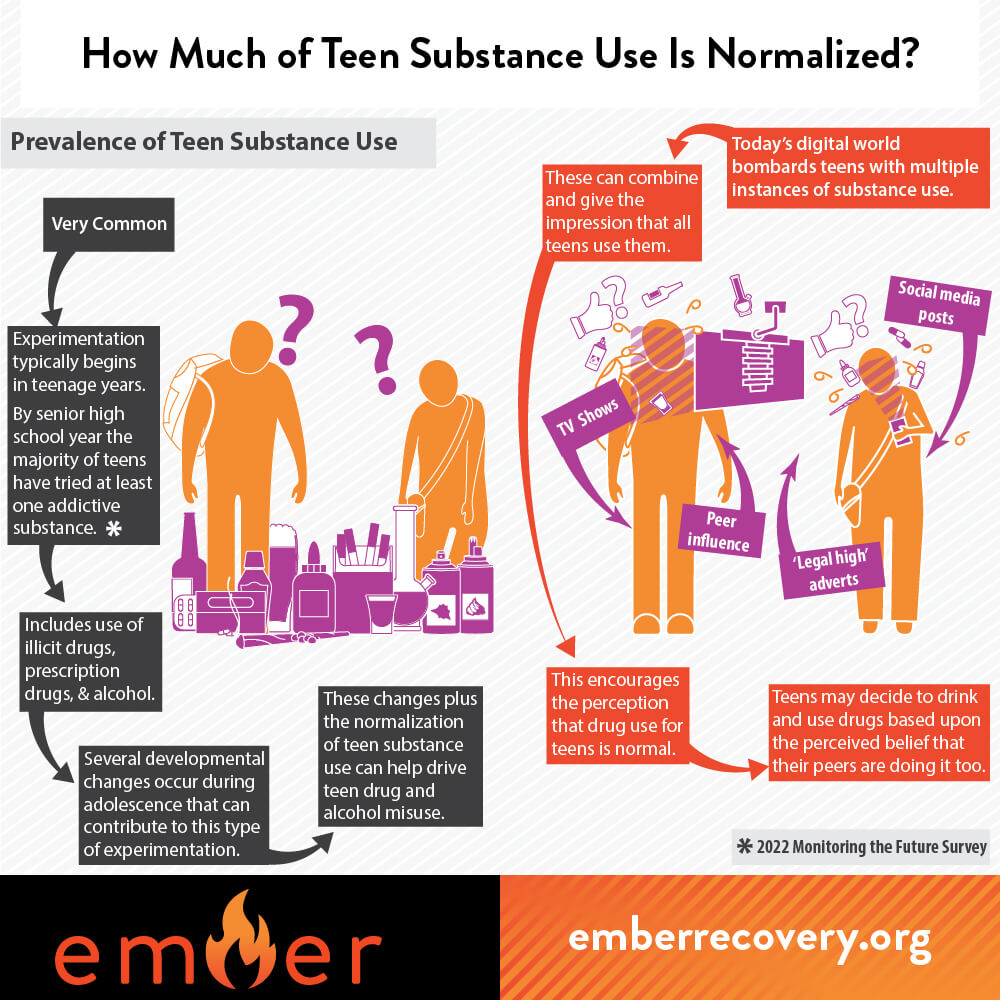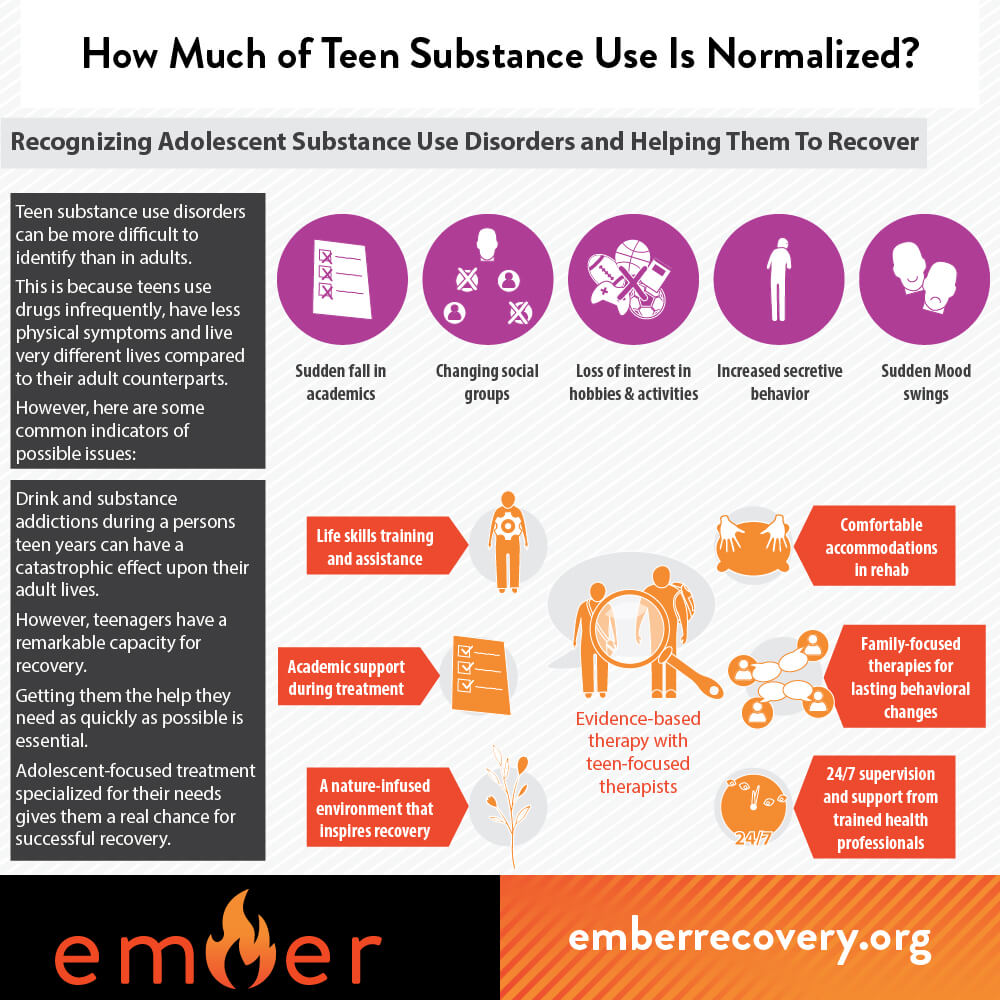Teen substance use is exceptionally common due in no small part to the normalization of teenage substance use from popular media, cultural norms, and peer pressure. But while teens using drugs may not be surprising, it is concerning. Teen drug abuse can rapidly turn into a substance use disorder and veer an adolescent’s entire life off course if they don’t get the help they need.
Prevalence of Teen Substance Use
Experimentation with substance use typically begins in the teenage years. According to the 2022 Monitoring the Future Survey, by the senior year of high school, the majority of teenagers will have used at least one addictive substance.[1] This includes recreational use of illicit drugs, prescription drugs, and alcohol.
Adolescence is marked by several developmental changes that can contribute to experimentation with drugs and alcohol. Teenagers are beginning to gain independence, seek to differentiate themselves from their parents, and are highly motivated by social influences. This combination of changes, paired with the normalization of teenage substance use, can drive teens to drug and alcohol misuse.
The Normalization of Teen Substance Use
In today’s digital world, teenagers are bombarded with media, advertisements, and social influences that can all encourage substance abuse. In just a single day, a teenager may see:
- A popular television show with teenagers using drugs or alcohol
- Social media posts of young adults using drugs or alcohol
- Advertisements for alcohol, cannabis, or “legal highs” such as kratom
All of these contribute to how teens can quickly feel as though using substances is normal for people their age, which can make them feel more comfortable increasing the amount of drugs or alcohol they use.
When teenagers believe that it is normal for people their age to use addictive substances, they are much more likely to engage in substance use themselves. Peer influence and behavior weigh heavily on adolescents’ health choices, even if they are only perceived behaviors.
Put another way, when teenagers think that everybody around them uses drugs or alcohol, they may drink or use drugs themselves — even if the actual amount of substances used by their peers is lower than they believe.
How Substance Use in Adolescence Can Quickly Turn to Addiction
Any adolescent substance use is high risk. The adolescent brain is in a critical development phase, and the habits, coping mechanisms, and behaviors instilled during this crucial period can last well into young adulthood and beyond.
Further, teens who use drugs or alcohol tend to gravitate toward other teenagers with similar substance use behaviors.[2] This can become inherently self-reinforcing, as teens in peer groups that use more addictive substances tend to follow in step.
This can rapidly turn from experimental drug use into a full-blown addiction, causing several physical and mental health problems that can prevent a teenager from succeeding in school, building healthy habits, and successfully gaining independence.
Risk Factors for Teen Addiction
While there is no single cause for substance use disorders, scientists have identified several different risk factors that can contribute to a teenager developing an addictive relationship with drugs and alcohol. Some of the common risk factors include:
- Family history of substance use disorders
- Early initiation of substance use
- Co-occurring mental health conditions
- Adverse childhood experiences
- Conduct problems
While these risk factors don’t guarantee that a teenager goes on to develop a substance use disorder, they should be a cause of concern when a teenager starts using drugs or alcohol.
Recognizing Adolescent Substance Use Disorders
Teen substance use disorders are often more challenging to identify than adult substance use disorders. Teenagers tend to use substances sporadically, show fewer physical symptoms of addiction, and are on entirely different life trajectories than adults.
Common signs of substance use disorders in teens include:
- A sudden drop in academic performance
- Changing social groups
- Loss of interest in hobbies or activities that used to be important
- An increase in secretive behaviors
- Sudden mood changes
Despite the difficulty in detecting addiction in teenagers, this period is also critical to helping them find effective treatment options that support their needs as young people.
How to Help Teens Recover
Teenagers living with a substance use disorder are at a critical turning point. When it is left unchecked, adolescent substance use can rapidly transition into adulthood and cause several catastrophic consequences that can make achieving recovery even more difficult.
However, teens have a remarkable capacity for recovery. Getting help for your teenager at an evidence-based addiction recovery center is often the best way to help your adolescent make this change and learn the skills of recovery to last a lifetime.
Yet just as teenagers show different signs of addiction than adults, they often require specialized treatment interventions as well. At Ember Recovery, our drug and alcohol rehab has been designed specifically for adolescents. We focus on what matters most to teens, using treatments intended for adolescents and helping family members join the treatment process.
The drug and alcohol treatment program at Ember Recovery provides adolescent-focused treatment that works. Our comprehensive treatment program includes options such as:
- Evidence-based therapy with teen-focused therapists
- Life skills training and assistance
- Academic support while teens are in treatment
- A nature-infused environment that inspires recovery
- Comfortable accommodations for teenagers in rehab
- Family-focused therapies to produce lasting behavioral change
- 24/7 supervision and support from trained mental health professionals
With all of these facets in hand, the path to recovery is open for any adolescent struggling with substance use.
Start Treatment at Ember Recovery
When your teenage son or daughter is struggling with substance use, the team at Ember Recovery can help guide them toward a healthier and more productive life in recovery. Reach out to our team of professionals today by calling (515) 461-8556 or filling out our confidential online contact form for more information.
Sources:
[1] https://monitoringthefuture.org/wp-content/uploads/2023/01/mtfoverview2022.pdf [2] https://www.ncbi.nlm.nih.gov/pmc/articles/PMC9706817/
Andrea Dickerson is a Licensed Therapist and Certified Substance Use Counselor who has worked in behavioral health since 1997. Currently, Andrea is the Director of Behavioral Health, overseeing the Ember residential treatment programs and YSS outpatient counseling clinics throughout Central and North Central Iowa. She became a Motivational Interviewing (MI) trainer in 2006 and provides MI trainings throughout Iowa.
Andrea specializes in working with adolescents and their families and enjoys seeing the family relationships grow through therapy. Andrea is also a CARF International Surveyor, going around North America ensuring behavioral health organizations are meeting required standards.
In her free time, Andrea enjoys cheering on the Iowa Hawkeyes and Chicago Cubs, as well as being an active member of Soroptimist International of the Americas (SIA), a global organization that provides women and girls with access to the education and training they need to achieve economic empowerment. She has been a member of the SI of Des Moines club since 2012 and has been actively involved at the regional level, currently serving as Co-Governor of the Peaks to Plains Region.
Through her involvement in SIA, Andrea has been actively involved in the Dream Programs, coordinating annual Dream It, Be It: Career Support for Girls projects, which give girls the tools they need to achieve their education and career goals, empowering them to break cycles of poverty, violence, and abuse.



